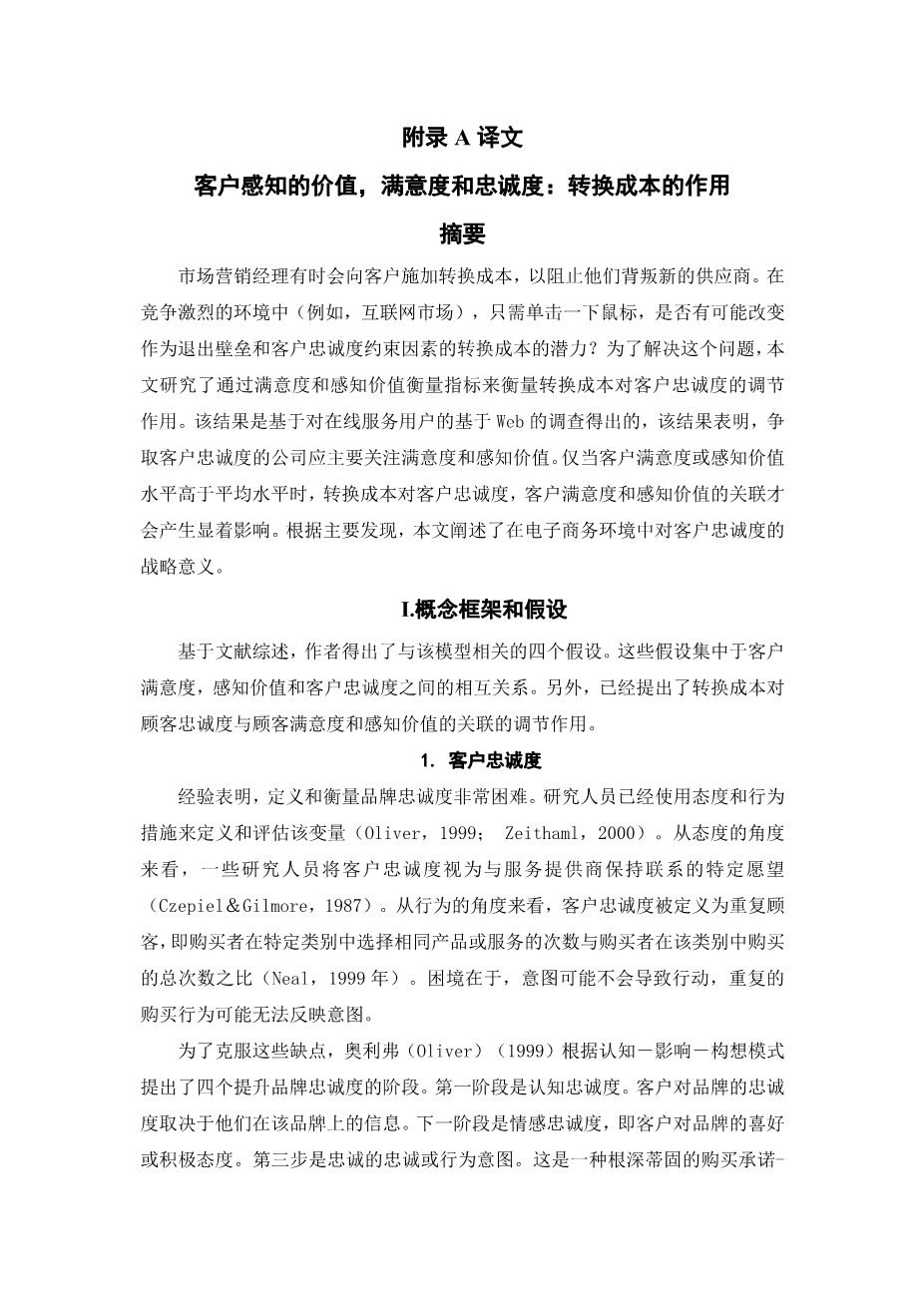附录B外文原文
Customer Perceived Value, Satisfaction, and Loyalty: The Role of Switching Cost
Abstract
It is a marketplace reality that marketing managers sometimes inflict switching costs on their customers, to inhibit them from defecting to new suppliers. In a competitive setting, such as the Internet market, where competition may be only one click away, has the potential of switching costs as an exit barrier and a binding ingredient of customer loyalty become altered? To address that issue, this article examines the moderating effects of switching costs on customer loyalty through both satisfaction and perceived-value measures. The results, evoked from a Web-based survey of online service users, indicate that companies that strive for customer loyalty should focus primarily on satisfaction and perceived value. The moderating effects of switching costs on the association of customer loyalty and customer satisfaction and perceived value are significant only when the level of customer satisfaction or perceived value is above average. In light of the major findings, the article sets forth strategic implications for customer loyalty in the setting of electronic commerce.
Ⅰ. CONCEPTUAL FRAMWORK AND HYPOTHESES
The conceptual framework guiding this study is presented in Figure 1. Based on the literature review, the authors have generated four hypotheses associated with the model. These hypotheses focus on the interrelationships among customer satisfaction, perceived value, and customer loyalty. In addition, the moderating effects of switching costs on the association of customer loyalty with customer satisfaction and perceived value have been proposed.
1.Customer Loyalty
Experience indicates that defining and measuring brand loyalty is extremely difficult. Researchers have used both attitudinal and behavioral measures to define and assess this variable (Oliver, 1999; Zeithaml,2000). From an attitudinal perspective, customer loyalty has been viewed by some researchers as a specific desire to continue a relationship with a service provider (Czepiel amp; Gilmore, 1987). From a behavioral view, customer loyalty is defined as repeat patronage, that is, the proportion of times a purchaser chooses the same product or service in a specific category compared to the total number of purchases made by the purchaser in that category (Neal, 1999). The dilemma lies in the fact that intention may not lead to action, and repeated buying behavior may not reflect intentions.
To overcome these drawbacks, Oliver (1999) has proposed four ascending brand-loyalty stages according to the cognition–affect–conation pattern. The first stage is cognitive loyalty. Customers are loyal to a brand based on their information on that brand. The next phase is affective loyalty, which refers to customer liking or positive attitudes toward a brand. The third step is conative loyalty or behavioral intention. This is a deeply held commitment to buy—a “good intention.” This desire may result in unrealized action. The last stage is action loyalty, where customers convert intentions into actions. Customers at this stage experi- ence action inertia, coupled with a desire to overcome obstacles to make a purchase. Although action loyalty is ideal, it is difficult to observe and is often equally difficult to measure. As a compromise, most researchers tend to employ the conative or behavioral-intention measure.
Loyalty can be of substantial value to both customers and the firm. Customers are willing to invest their loyalty in business that can deliver superior value relative to the offerings of competitors (Reichheld, 1996). When they are loyal to a firm, consumers may minimize time expended in searching and in locating and evaluating purchase alternatives. Also, customers can avoid the learning process that may consume the time and effort needed to become accustomed to a new vendor.
Customer loyalty is one major driver of success in e-commerce (Reich- held amp; Schefter, 2000). Loyal customers often will, over time, bring in substantial revenues and demand less time and attention from the firms they patronize. Many customers are inclined to forgive customer-service mishaps, display decreasing sensitivity to price, and disseminate positive word-of-mouth about the business to others. As a result, customer loyalty can be a major source of sustained growth and profit and a strong asset (E. W. Anderson amp; Mittal, 2000).
2.Customer-Perceived Value
Perceived value has its root in equity theory, which considers the ratio of the consumerrsquo;s outcome/input to that of the service providerrsquo;s outcome/input (Oliver amp; DeSarbo, 1988). The equity concept refers to cus- tomer evaluation of what is fair, right, or deserved for the perceived cost of the offering (Bolton amp; Lemon, 1999). Perceived costs include mone- tary payments and nonmonetary sacrifices such as time consumption,energy consumption, and stress experienced by consumers. In turn, customer-perceived value results from an evaluation of the relative rewards and sacrifices associated with the offering. Customers are inclined to feel equitably treated if they perceive that the ratio of their outcome to inputs is comparable to the ratio of outcome to inputs experienced by the company (Oliver amp; DeSarbo, 1988). And customers often measure a companyrsquo;s ratio of outcome to inputs by making comparisons with its competitorsrsquo; offerings.
Customer value is “the fundamental basis for all marketing activity” (Holbrook, 1994, p. 22). And high value is one primary motivation for customer patronage. In this regard, Sirdeshmukh, Singh, and Sabol (2002) argue that customer value is a superordinate goal and customer loyalty is a subordinate goal, as it is a behavioral intention. According to goal and action identity theories, a
剩余内容已隐藏,支付完成后下载完整资料


英语译文共 8 页,剩余内容已隐藏,支付完成后下载完整资料
资料编号:[412708],资料为PDF文档或Word文档,PDF文档可免费转换为Word
以上是毕业论文外文翻译,课题毕业论文、任务书、文献综述、开题报告、程序设计、图纸设计等资料可联系客服协助查找。


